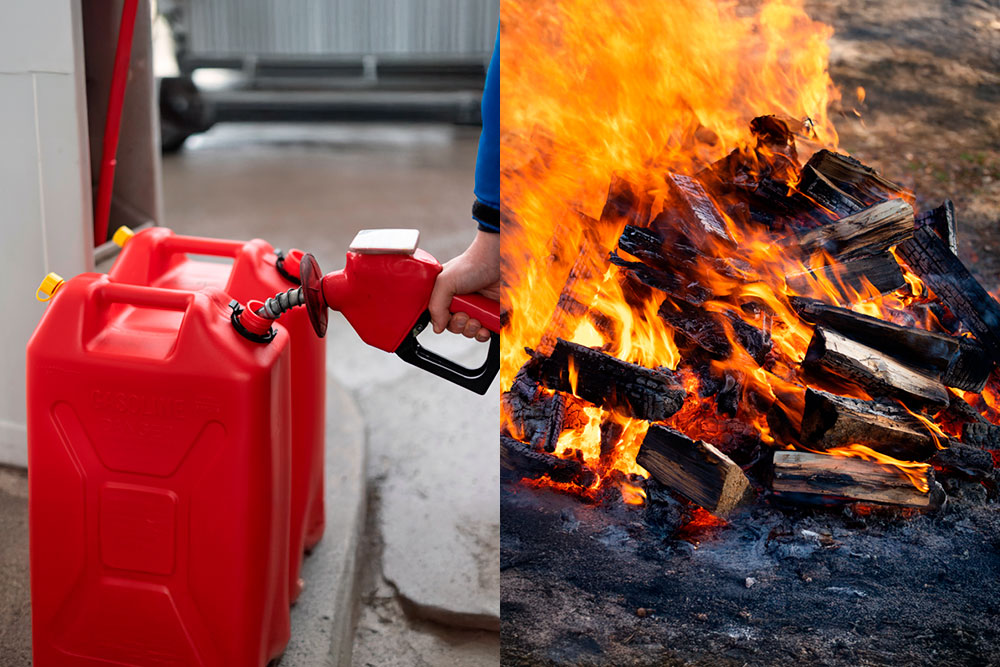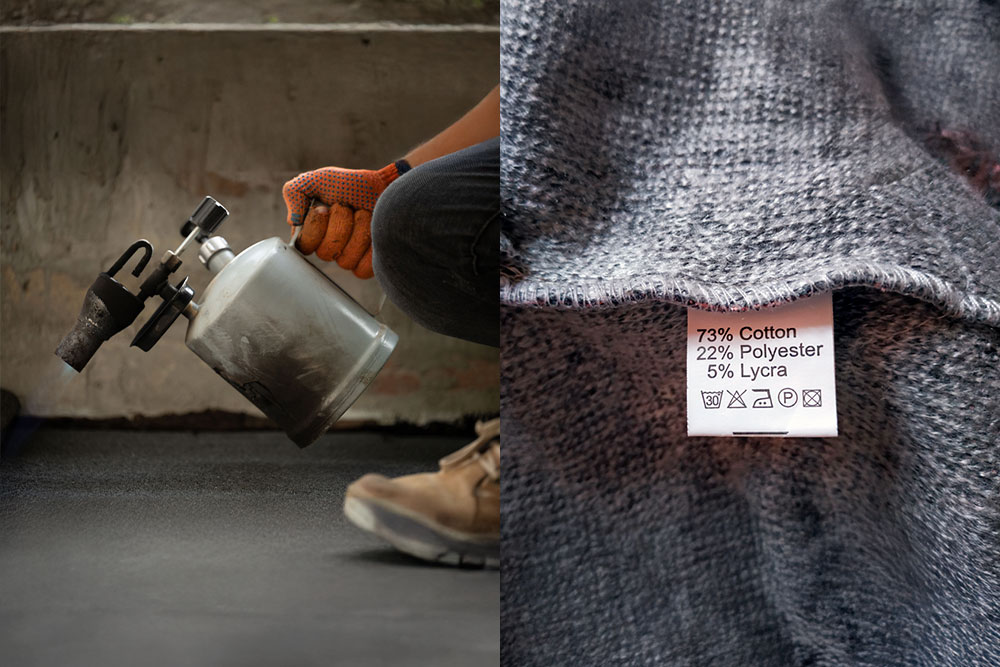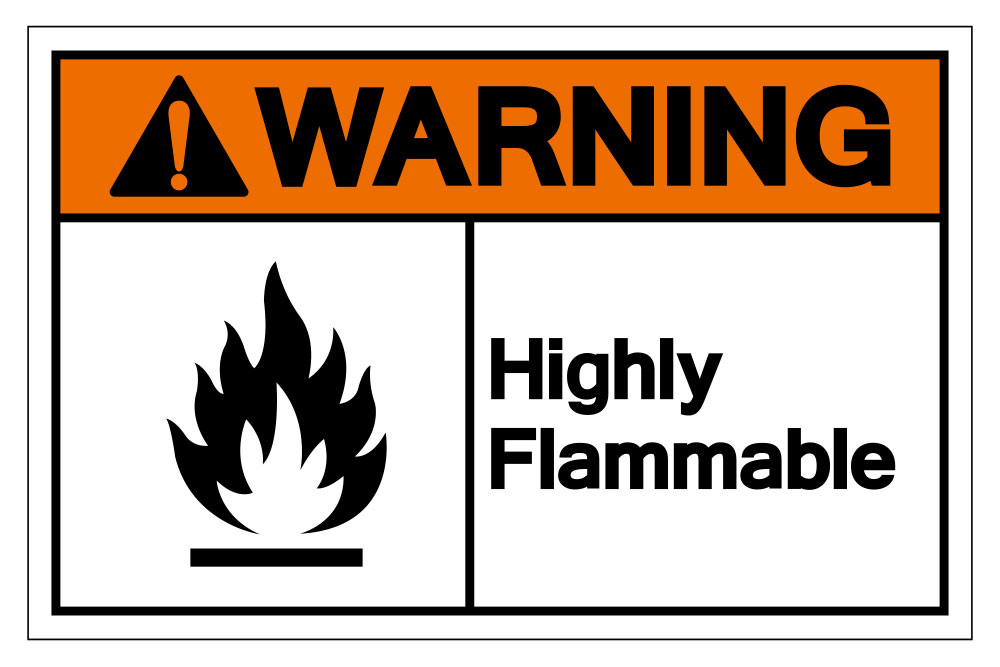
Most workplaces contain various materials and liquids that pose a significant fire risk. But do you know the significance of flammable vs combustible liquids and materials?
You must understand the difference between flammable and combustible materials to control fire risks on your business premises. In this article, we define flammable and combustible materials and explain how you can keep your workplace safe.
Flammable vs Combustible – Why You Need to Know the Difference
Once it’s started, a fire can rip through a building in minutes, destroying stock, damaging the premises beyond repair and taking lives. To stay safe, business owners must be aware of the properties of all the materials or liquids on their premises that could start or accelerate a fire.
Some materials are more easily ignitable than others. This makes them more hazardous to work with. It also presents challenges to storing them safely. Developing effective fire safety procedures means knowing the difference between flammable and combustible materials and liquids.
Why Fire Safety Law Should Be Your No.1 Priority
The consequences of not being vigilant about fire safety laws can be devastating for a business. A fire can race through a building in minutes, destroying everything in its wake. It only takes one mistake to wreck a business totally. Staying safe means always being aware of the enormously destructive potential of fire.
Recently, an explosion caused by the improper handling of flammable liquid at John Winters & Company Limited of Halifax was investigated. In April 2021, an enormous fire erupted at the dental supply company that caused massive amounts of damage, according to the HSM.
A worker incorrectly poured heptane from a metal drum into a plastic bulk container. The spill from this simple act caused a static charge that sparked an explosion. It was made worse by the incorrect storage of cardboard boxes that added fuel to the fire. The premises were quickly engulfed in flames. More than 60 firefighters fought to extinguish the blaze. Luckily, no one was hurt or killed in this incident.
The company was found guilty of breaching the Health and Safety at Work etc. Act 1974 and fined £30,000 and ordered to pay an additional £8,030.94 in costs. HSE inspector Andrea Jones said: “Implementing appropriate control measures when handling flammable liquids is essential.”
Flammable Material and Combustible Materials – What’s the Difference?
The flammability and combustibility of a material are determined by the temperature at which it will catch fire, known as its flash point. Essentially:
- Flammable materials have significantly lower flash points. They can catch fire at ambient temperatures if exposed to an open fire.
- Combustible materials are considered less hazardous because they have a higher flash point. They need to heat up before catching fire when exposed to an open fire. However, once combustible materials start to burn, the fires become self-sustaining.
Fire Safety Training
Our Fire Safety Training course gives a basic understanding of fire prevention principles, the sources of ignition and fuel and safe systems of work to prevent fire hazards and accidents within the work environment.
What Are Combustible Materials?
To be considered combustible, a material or liquid must have a flash point greater than 37.8°C and below 93.3°C. Most workplaces aren’t at a temperature exceeding the lowest combustible flash point of 37.8°C. So, combustible materials aren’t likely to form vapours that can be ignited by a spark and turn into a blaze.
Common combustible materials include:
- Wood
- Paper
- Coal
- Plastic
- Straw
- Cloth

Some common combustible liquids and their flash points are:
- Diesel: 52 to 82°C
- Lube oil: 187°C
- Paint thinner: 40°C
- Vegetable oil: 315°C
- Olive oil: 210°C
- Formaldehyde: 64°C
Although they have a relatively high flash point, combustible liquids should still be kept in special storage facilities.
All combustible materials need to be held in an orderly fashion, as build-ups can present a considerable fire risk. Think about a pile of cardboard boxes left in a corner or a stack of tins of cooking oil. Both of these seem innocuous enough. But if a fire occurs, that stack of combustible materials and liquids will give the blaze the fuel it needs to rage out of control and consume a building.
What Are Flammable Materials?
Flammable materials and liquids are more hazardous than combustible materials and liquids. To be considered flammable, a material or liquid must have a flash point below 37.8°C. Flammable materials can easily form vapours that can start a fire as they have a lower flash point.
Common flammable materials include:
- Polyester
- Cotton
- Flour
- Nylon
- Acrylic
- Linen

Some common flammable liquids and their flash points are:
- Petrol: -43°C
- Acetone: -20°C
- Benzene: -11°C
- Methanol: 12°C
- Kerosene: 38°C
- Ethanol: 16.6°C
So, if you keep any flammable liquid with a flash point of 20°C, you must store it in an environment that’s lower than this temperature. Some liquids have flash points beneath – 0°C. So, extra precautions must be taken.
Petrol gasoline, for instance, has a flashpoint of around -43°C. Diesel fuel has a flash point of between 52 and 82°C. You can easily see that more care needs to be taken when storing petrol gasoline than diesel fuel.
Always be on guard and aware of the high risks of using and storing flammable materials.

Table of Differences
The following table summarises the differences between flammable and combustible materials.
| Aspect | Flammable Materials | Combustible Materials |
|---|---|---|
| Flash Point | Below 37.8°C | Between 37.8°C and 93.3°C (some higher for certain liquids) |
| Ease of Ignition | Can ignite at room/ambient temperatures | Require heating before ignition |
| Vapour Formation | Easily form vapours that ignite quickly | Less likely to form vapours at normal temperatures |
| Examples (Solids) | Cotton, polyester, flour, nylon, acrylic, linen | Wood, paper, coal, straw, cloth, plastics |
| Examples (Liquids) | Petrol (-43°C), acetone (-20°C), benzene (-11°C), methanol (12°C), ethanol (16.6°C) | Diesel (52–82°C), lube oil (187°C), vegetable oil (315°C), olive oil (210°C), paint thinner (40°C) |
| Risk Level | Higher fire hazard – more volatile | Lower than flammables but still dangerous |
| Storage Needs | Must be kept below their flash point in sealed, labelled, temperature-controlled containers | Require safe storage to prevent build-up; still hazardous if large quantities are present |
A Note About Definitions
Flammability is a property of combustible materials, i.e., combustible materials that burn easily are considered flammable. This means all flammable materials are combustible, but not all combustible materials are necessarily flammable.
Additionally, a material that’s only combustible in one state may be flammable in another state. For example, wet wood can be quite difficult to ignite, but wood dust is highly flammable.
It’s important to remember that flammablity and combustibility only refer to difficulty in causing a material to catch fire. The line isn’t always clear, and differentiating between materials this way can be unhelpful. Fortunately, there’s a better way.
What Do the Classes of Flammable and Combustible Materials Mean?
The Euroclass system described in BS EN 13501-1 provides a standardised method for classifying materials based on their reaction to fire.
In terms of flammablity and combustibility, the Euroclass system categorises materials into the following classes:
- Class A1: No contribution to fire at all.
- Class A2: Very limited contribution to fire.
- Class B: Very limited contribution to fire.
- Class C: Limited contribution to fire.
- Class D: Medium contribution to fire.
- Class E: High contribution to fire.
- Class F: Easily flammable with no determined performance to fire.
It’s important to note that different classification systems may be used in different contexts and industries.
Building Safety and Flammables and Combustibles
Flammable and combustible liquids and materials should never be exposed to ignition sources or kept in environments that are equal to or above their flash points. Any substance categorised as especially hazardous should come with an attached safety data sheet (SDS) provided by the manufacturer. The SDS should contain relevant information on the flash point of the substance and guidelines on how to use and store it correctly.
Some general rules to follow regarding flammable or combustible materials are:
- Do not store them near exits
- Do not store them near electrical equipment or heat sources
- Keep flammable or combustible materials away from incompatible substances
- Keep them in labelled, sealed containers – preferably those supplied by the manufacturer
- Keep flammable or combustible materials in temperature-controlled areas out of direct sunlight
- Only store the minimum amount of flammable or combustible materials required
- If possible, replace flammable or combustible materials with other substances
- Use personal protective equipment (PPE) when using flammable or combustible materials
- Develop safe work procedures and ensure they’re followed by everyone
- Regularly perform risk assessments
- Provide employees with adequate fire safety training
Overall, the presence of flammable and combustible materials in a building necessitates careful consideration and adherence to fire safety measures. Understanding their properties, implementing appropriate precautions, and complying with relevant regulations are essential for maintaining building safety and minimising the risk of a fire-related incident.
Where to Find Fire Safety Training
Fire safety training ensures you meet UK health and safety legislation obligations.
Industries and authorities across the UK recognise our Fire Awareness Training course. It teaches people about the correct safety measures to control or eliminate risks. Your team must have a solid knowledge of fire safety and remain vigilant to avoid accidents, reduce your fire risks and stay safe at work.






















